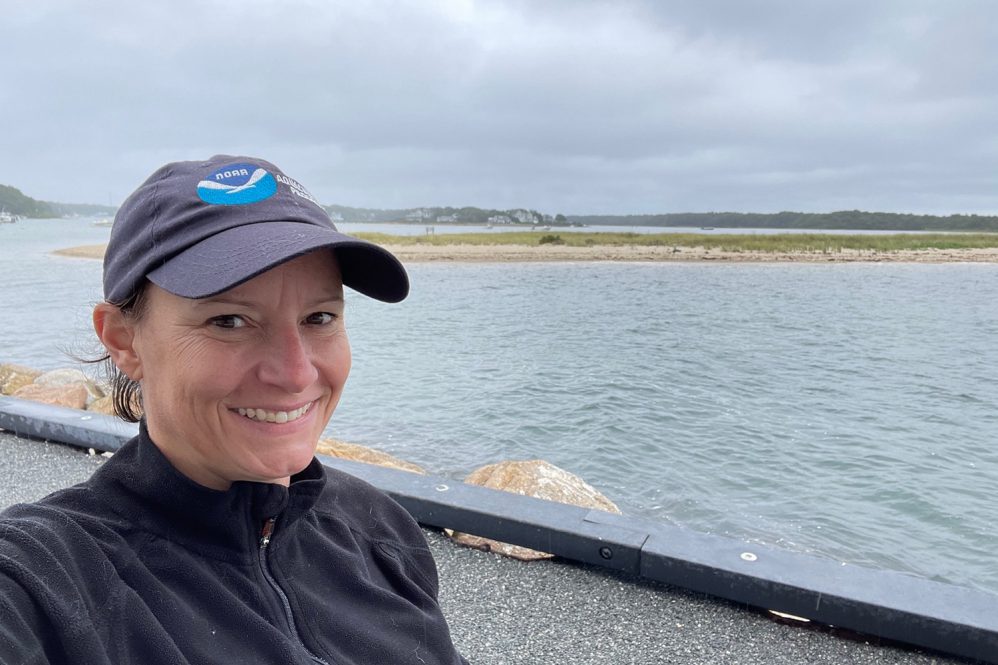UConn alumna and shellfish expert Lisa Milke ’01 (CLAS) was recently appointed as the new head of NOAA’s Ecosystems and Aquaculture Division. Milke grew up in Maryland and came to UConn Avery Point to pursue a master’s degree studying the feeding physiology of oysters and mussels. After some time abroad to earn her Ph.D., her expertise soon brought her back to Connecticut’s coast to continue studying shellfish with NOAA.
Milke recently met with UConn Today to talk about her new role.
Can you talk about your research background and what led you to this position?
Though I am now in a leadership role, I’m trained as a shellfish biologist and was a bench scientist for many years.
I did two internships in Maryland that set me on this shellfish research track. One of them was with Evan Ward, who later served as my mentor at UConn Avery point, and is now head of the marine science department. For my master’s degree, I studied the feeding physiology of mussels and oysters.
I moved to Canada to do my Ph.D. where I worked on shellfish physiology but focused more on answering questions relevant to the aquaculture industry, so an applied focus.
I moved back to Connecticut in 2005 to join NOAA’s Milford lab where my research has largely focused on the interactions between shellfish and the environment. The last hands-on research I was involved in focused on shellfish and phytoplankton responses to ocean acidification. It’s been a while since I’ve been in the lab doing benchwork.
Since then, I’ve moved into leadership roles at NOAA Fisheries, but I keep looped into the research as much as possible. I consider myself a science facilitator. My job is establishing partnerships to move things forward, coming up with funding, and getting facilities and equipment maintained and fixed. Marine labs require significant maintenance so I’m facilitating the science by helping to address these issues.
What brought you back to Connecticut?
It was the Milford lab that brought me back. I was living in Canada, loved it, and was planning to either stay there or go to New Zealand for a postdoctoral research position. The job at the Milford lab opened and they were looking for a shellfish physiologist, which was my exact skillset. The director of research where I was walked across the hall and said, ‘There is a job for a shellfish physiologist. You are a shellfish physiologist; this will never happen again. You are crazy if you don’t apply.’ I applied and ended up getting it.
Even though I’m not from Connecticut, I’ve spent over 20 years here at this point, and now consider it home.
As head of the ecosystems and aquaculture division, what plans do you have?
I really think we should be doing science that directly serves our stakeholders. This division has a lot of diverse stakeholders. It’s the aquaculture industry, the fishing industry, and ecosystem managers who are making tough decisions surrounding these and other topics. I want to make sure we’re doing the best, most relevant research we can do to support all those individuals and the complex decisions they have to make.
Aside from that broad overarching vision, there isn’t a one size fits all plan. We’re a broadly diverse division in the science we do, where we’re located, and our scientific expertise. We have about 70 staff in four different locations from Sandy Hook, New Jersey, to Woods Hole, Massachusetts. We cover habitat studies and fishery ecology, deep-sea corals, aquaculture, climate change, ocean acidification, and plankton and hydrographic monitoring and research. That’s just some of what we do.
I don’t envision any large pivots from these broad topics, but our research changes to align with stakeholder needs. We are continually changing the questions that we’re asking and researching to make sure that our work is useful for the stakeholders. For example, topics in the region that I think we’re going to do a lot more research on include wind energy and climate change.
I think all the research branches can play a role as the offshore wind energy expands, looking at habitat impacts, plankton dynamics, and oceanographic changes, maybe colocation of aquaculture. That’s a little bit of where I think we’re going to go.
Can you talk a little bit about the environmental impacts of aquaculture?
Aquaculture is part of what the division does but I think when most people think about aquaculture and its impacts to the ecosystem, they have negative images. Much of this is based on the perception of aquaculture as it was conducted decades ago, not how it is done now.
A lot of the research we do particularly at the Milford Lab focuses on the positive effects aquaculture can have on the surrounding environment and the benefits that it can provide. Aside from growing food and providing jobs, shellfish aquaculture can remove excess nutrients that are in coastal ecosystems that would otherwise fuel algal growth.
There are studies happening to look at the economic benefits of this in Long Island Sound and Connecticut’s coastal towns. We also have a GoPro aquaculture project that has been continuing for multiple years now looking at how native fish species use aquaculture cages in a similar way to reef structures, so the gear is creating an environment for fish, growing food and providing jobs and economic opportunities to coastal communities.



